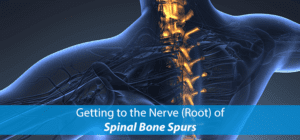
Getting to the Nerve (Root) of Spinal Bone Spurs
Bone spurs, or osteophytes, are small outgrowths of bone that appear along the edges of our bones. Typically, these structures develop over time, usually forming at the joints in various places throughout the body. For example, bone spurs may pop up in the hands, spine, hips, shoulders, knees, feet, and much more. Despite what most may think, bone spurs are actually round and smooth—not rigid or rough around the edges as the name might suggest. Additionally, not all bone spurs cause symptoms. A patient may be walking around with bone spurs at any point in his or her body without experiencing any problems whatsoever. Bone spurs only tend to hurt in cases where they press on adjacent nerves or rub against other structures. In such instances, the patient may also experience stiffness in addition to pain. Bone spurs are most common in patients who are age 60 or older. Unfortunately, a good chunk of osteophyte cases will require treatment. Studies estimate that roughly 40% of people with bone spurs must seek out medical consultation for the condition. Why Spinal Bone Spurs Occur Bone spurs usually form when something goes awry surrounding a joint in the body. The most common cause for osteophytes is osteoarthritis, which is a degenerative disease that wears down joint cartilage. Cartilage is a protective structure, and when it goes away, the bones become much more vulnerable to inflammation and other structural changes. The lack of cartilage leads to the thickening of ligaments, as well as the formation of calcium deposits. This leads to excessive bone growth, which is what ultimately causes bone spurs. In essence, bone spurs are like the joint’s natural reaction to overexposure. Spurs form as a means to increase the surface area of a vulnerable joint. This reduces pinpoint pressures that outside forces apply to the joint each day. Although this seems like it would be a good thing, it sadly does not pan out that way. Instead, this process ends up reducing the mobility of the joint in addition to compressing nearby nerves and soft tissues. Bone spurs may also form from diffuse idiopathic skeletal hyperostosis (DISH). This is a non-inflammatory disease with an unknown cause. However, those who do have the condition have a very high chance of forming bone spurs along the spine. In fact, 80% of patients with DISH will experience painful symptoms as a direct result of spinal bone spur formation. Symptoms of Osteophytes In the vast majority of cases, bone spurs are inconsequential, causing no painful symptoms whatsoever. These structures may form in a variety of places, which may affect how symptoms manifest. For example, when bone spurs occur in the fingers, there may be small visible bumps along the joints. Typically speaking, if symptoms do occur, then they are most likely to occur in patients who are age 60 or older. In patients who are age 60 and older, roughly 40% of people will require medical treatment for osteophytes. Bone spurs may also occur in the
